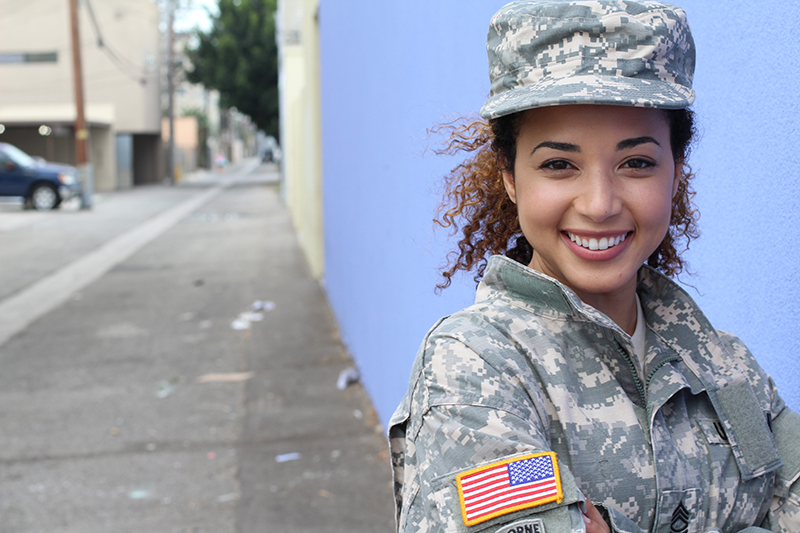New military spouse Russ Shumaker stumbled upon a merit based scholarship simply by visiting the admissions office down the road. “I went to explore my options and they told me about a scholarship that was available to everyone based on GRE scores,” he said. As a graduate student and military spouse, Shumaker is looking to succeed in the business world and wants to be competitive, despite the many moves and job changes he will face. He’s one of the “nontraditional” students in his program.
When the GI Bill was first created as the Servicemen’s Readjustment Act of 1944, the intention was to help World War II veterans get back on their feet. It provided them with low-interest mortgages, established hospitals and, as it does now, gave stipends for tuition and expenses associated with college or trade schools. In the first five years, over $4 billion was dispersed.
After more than 15 years of the Global War on Terror, the military is once again evolving. More young veterans are leaving the military and heading to college, thanks to the GI Bill. Those who serve long enough can transfer their benefits to their spouse and/or children. Generations of military students are applying to college and universities throughout the country, and they are looking for admissions policies and offices that are willing to help.

Who are military students?
Nontraditional military students are comprised of several different groups, each of which face their own set of obstacles. Veterans, those still serving on active duty, military spouses and the children of service members are all part of this group of nontraditional students.
According to recent research by the National Conference of State Legislatures (NCSL) Veterans and College, over 1 million veterans and family members use the post-9/11 GI Bill. What is less clear, however, is the breakdown of veterans, active duty and military spouses who are actually taking the classes. For the purposes of staying within the nontraditional student, we will remove children of military veterans/active duty from the equation, as they are within the traditional age range and marital status of college students.
With the changeover from the Montgomery GI Bill to the post-9/11 GI Bill in the 2009-2010 school year, there was a 42% increase in the number of veterans receiving education benefits. Who are these military students?
- 62% of veteran students are also the first in their family to attend college.
- 85% of veteran students are at least 24 years old.
- 47% of veteran students have a spouse and/or children.
- 27% of veteran students enrolled in postsecondary education are women (even though they only make up 10-12% of military personnel).
Veteran students are more likely to attend more than one institution throughout their education, especially those who are attending while on active duty. Over one third of veterans are likely to utilize their GI Bill after they have earned a degree or certificate. And they don’t stop there.
Though military personnel come from a variety of backgrounds and perform a variety of jobs while on active duty, when it comes to their educational pursuits, they seem to gravitate towards the same degree programs. As listed in this Inside Higher Ed report, veterans are interested in business, social sciences, homeland security, law enforcement and computer and information sciences at the bachelor’s degree level.

What changes are we seeing in the military community in regards to education?
Between 2000 and 2012, over 900,000 veterans and service members have gone “back” to school, utilizing their GI Bill benefits. As veterans look at their future, they are viewing education differently than before. Not all of them are interested in continuing education for advanced job placement.
Jax Taylor, a retired Army soldier, just started a small business and is honest in her reasons for continuing education: “In the short term, I want to go to school to earn some form of income through the BAH (housing allowance) provided. I just started a small business and it isn’t earning enough money yet. In the long term, I would like to learn more about how the government works so I can eventually go into political office.”
For those on active duty status or who are military spouses, online education options are often the only option for continuing education. Student Veterans of America (SVA), an organization that advocates for veteran students, brings up some great points about the level of dedication these nontraditional students bring, and how it can benefit the institution they are attending.
“The majority of student veterans accessing their G.I. Bill benefits are completing degrees and showing unparalleled determination to do so, despite many unique barriers,” said Wayne Robinson, SVA’s president and CEO, in a written statement. “A single deployment can interrupt a student veteran’s education for at least 9 to 13 months, but they’re returning to the classroom and completing.”
Like Taylor, veterans are looking for some direction and a chance to figure out what they want to do outside of the military. Transition is stressful and college can be a way to ease back into the civilian world, but it comes with its own set of challenges.
What are their challenges?
The challenges military students face when applying to and attending college are as wide and varied as traditional students, but they still deserve discussion. The top concerns come during the application process and include things like outdated transcripts, navigating the process of using GI Bill benefits and figuring out what their next steps are.
Along with concerns about “fitting in” to the traditional college atmosphere — while also balancing family, and potentially, work responsibility — veteran students often have additional obstacles that need to be addressed before they even step foot in a classroom.
For military students who face cognitive, ambulatory or multiple disabilities, the application process may feel overwhelming. Admissions offices and institutions that understand this are going to gain credibility in the veteran community and see an increase in applications from veteran students.
Some of the challenges facing military students are misconceptions that haunt them throughout their post-military lives. Stereotypes such as “all veterans have PTSD” and “all military spouses are women” are hurting the chances of these students succeeding. Yes, active duty students and military spouses are going to move frequently, hindering their chances of completing a program all in one place. Yes, some veteran students are going to have a hard time deciding what they want to study as they are also figuring out a new lifestyle. But there are services and organizations to help with these obstacles, and they can be incorporated into college campuses easily.

How can admissions offices change to help these military students?
Admissions offices that have someone trained and well-versed in veterans’ concerns and the GI Bill process do well to support military students. Very simply put, compassion goes a long way with the military community. Acknowledging that the application process is difficult, for example, can endear military students to their admissions offices.
Veterans undergo extensive training, most of which can be applied towards college credit. Community colleges have programs in place to assist military students who are working on associate’s degrees with minimal extra coursework, in order to help them advance their education. While each state has different requirements regarding applying military training towards academic credit, this is an area where progress can and should be made. Institutions could lobby their state commission or board of education to make this process easier.
A study by the Pat Tillman Foundation, Got Your 6 and Operation College Promise states that veteran students, despite all the obstacles they face, average 24.5 credits per year, which, combined with transfer credits from prior learning or military experience, put them on the path to graduate in four years. However, transferring credits can be especially hard for military students.
Taylor would like to see institutions consider waiving transcripts submissions for older courses. “I’m having a very hard time obtaining my transcripts from the classes offered on deployment,” she explained. “If I can’t figure out some way to obtain them, they may not allow me to start school.” She goes on to say that it would appear to be easier if she had left out all of her previous education and started as a freshman. “None of the classes I took add up to a degree and the classes I took are too old to transfer. It seems like a huge waste of time.”
The next steps towards making a difference
“There are three types of heroes that I see in our nation: military, farmers, and entrepreneurs,” Taylor explained. “These are the groups of people that keep America moving forward. I joined the army in 2003 and spent time in Iraq and Afghanistan among other places across the nation and the world. I spent a total of 14 years active duty before being medically retired. I knew after being a soldier there were two positions I still needed to fill.”
Taylor began a goat farm and three goat-related businesses in January of 2017. With a desire to continue serving her community, she wants to use her military experience and future education to make a positive change for younger generations. “I know there is no way to be effective in making change without knowledge of how our government works and creating the right connections. Right now I’m on a mission to finish my enrollment and begin fostering relationships with my local leaders.”
Education is a stepping stone for service members and their families to continue to serve their communities. Because they’ve spent years risking their lives so others could have the chance at an education, to better their circumstances, steps that can be taken to make the path to education easier for them are steps in the right direction.